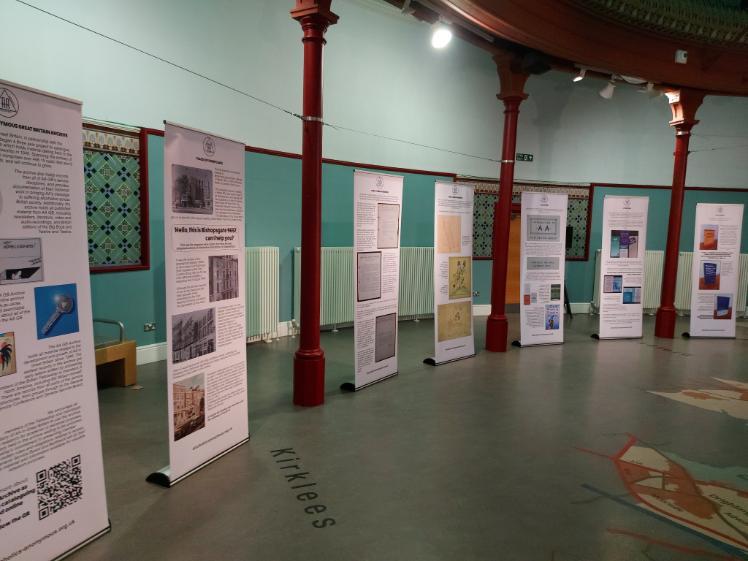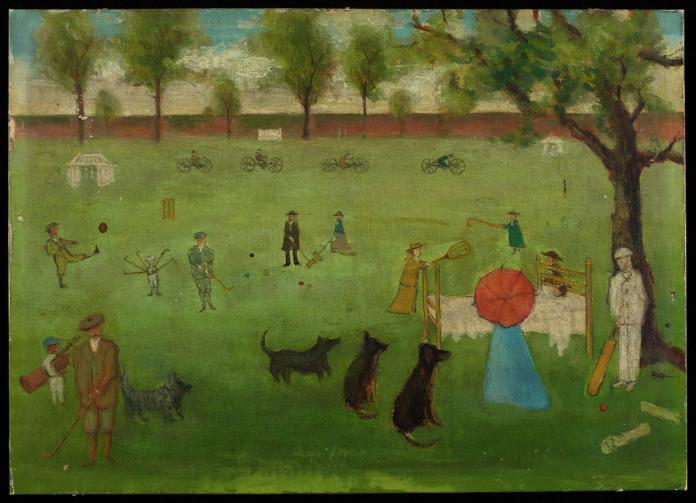Borthwick Newsletter - July 2022
Posted on 29 June 2022
July in the Archives - delve into our catalogues with this month’s featured description
Letter from Vernon Musgrave, age 12, to Mr Bagfield, describing his holiday in Ireland, 13 July 1840 [Musgrave Papers, MUSG/4/2]
What’s New?
We’ve had a very busy month at the Borthwick. As well as taking part in the York Festival of Ideas, it’s been all hands on deck as we began work on the refurbishment of the shelving in our two main strongrooms. This work is expected to run until the Autumn and represents the first major work on the shelves since the Borthwick moved to the University of York campus in 2005. At the time, our electric shelving was state of the art, but natural wear and tear (and heavy usage!) over the past 17 years means it is long overdue an upgrade.
To accommodate the work we have had to close the searchroom for the final two weeks of June and we will also be closed for a further week in July, from the 18th to the 22nd. This is to allow all staff to assist with the preparation of selected collections for temporary offsite storage, a process which involves carefully recording information about, and equally carefully barcoding and scanning, thousands of boxes of material. We appreciate that this will cause some disruption to our usual service, but searchroom staff will be available to answer most enquiries as usual and will be happy to advise on visiting and copying or research requests. We would ask that anyone wishing to visit the Borthwick in the next few months please contact us in advance by email, phone or letter, so we can make sure we have a space reserved for you in the searchroom and that your archives are ready for you onsite.
New Accessions
In June we accepted a small gift of material with particular relevance to the Borthwick; some additional papers of our first Director, Canon John Stanley Purvis. Canon Purvis was appointed Diocesan Archivist at York in 1939 and he would later play a key role in the foundation of the Borthwick Institute in 1953. He was responsible for much of the early sorting and arranging of the enormous York Diocesan Archive, one of our largest and most important collections, which he found at the Minster in cramped and dirty storage that left ‘very much to be desired’. He was also a published First World War poet and a notable scholar and artist. He helped to revive York’s medieval Mystery Plays in 1951 and published books, pamphlets and articles on a wide range of historical and archival subjects. The new addition includes correspondence, art work, and family papers, photographs and memorabilia, as well as an intriguing sounding poem by a very young Purvis, aged 9, called ‘The Tiger’. The new material will be added to the existing Records of John Stanley Purvis catalogue and you can read more about Canon Purvis, and about the early history of the Borthwick, on our website.
We also received a very significant addition to our Frankie Howerd Archive, including some twenty years of Howerd’s business and fan correspondence. You can read more about the additions in the ‘New Catalogues’ section below.
New Catalogues
Number of archival descriptions on Borthcat on 1st July 2022: 94,923
The catalogue for the Frankie Howerd Archive has been updated to include thirteen boxes of new material, beginning at Box 37. Amongst the new items you can find a file on Howerd’s involvement with the Sgt Pepper’s Lonely Hearts Club Band film, starring the Bee Gees, as well as a wealth of press cuttings, scripts, photographs and audio and visual recordings. Howerd’s files of fan mail are a particularly valuable addition to the archive, giving an insight into his popularity over the years and how he interacted with his fans. It's clear that this interaction was important to Howerd - some fans corresponded with him over extended periods of time, and even on occasion asked for his advice. We've even found one case where we know he financially supported a fan (on a small scale) too
We’ve also recently completed the first part of the catalogue for the Records of closed branches of the North Yorkshire East Federation of Women’s Institutes. The records date from the 1920s to the 1990s and cover over forty local institutes, with detailed minutes, account books and lists of members, as well as press cuttings, photographs and even a Royal visit or two.
Finally we have added the full catalogue for the Parish records of York, St Margaret Walmgate. The Church of St Margaret dates back to the twelfth century, though only the south porch survives from this early period. Most of the surviving church dates from the fourteenth century onwards and like many mediaeval churches, it was restored in the Victorian era, with stained glass supplied by York’s own J.W. Knowles & Sons. The earliest parish record dates to 1394, but the highlight of the archive is probably its early parish registers which contain some wonderful notes and ephemera. The first register covers the period 1574-1660 and includes verses on York and its history, on the Restoration of the monarchy and the outbreaks of plague, as well as a record of property disputes over six burgages in Walmgate. In fact this property dispute becomes quite the feature in the registers, as it is also detailed in the second register covering 1558-1700 and the third, covering 1701-1762. Clearly it was a long running problem! St Margaret’s Church became redundant when the parish was united with York, St Denys with St George. However it has found a new life as the National Centre for Early Music, continuing a long history of community use.
Borthwick Out and About
June was the 75th anniversary of Alcoholics Anonymous being established in Great Britain. In celebration, the British Fellowship held a weekend of activities in Leeds, which included a pop-up archive exhibition in Leeds City Museum. This well attended event held in the museum’s grand Brodrick Hall was organised in collaboration with the Borthwick, who selected and digitised key items from the Alcoholics Anonymous Great Britain (AA GB) Archive for display across eleven thematic banners. Feedback from both members of AA and the public was overwhelmingly positive, and the pop-up exhibition will continue to be toured across Great Britain in years to come.

Founded in 1935 in Akron Ohio by two suffering alcoholics; stockbroker Bill Wilson and medical doctor Bob Smith, or ‘Dr Bob’, AA and its Twelve Step Programme of Recovery has become world renowned for helping alcoholics achieve sobriety. The first AA meeting to take place in Great Britain was organised by a group of eight British and American alcoholics in the auspicious surroundings of a suite in the Dorchester Hotel. From that first initial meeting, attendees went on to form a First London Group, before spreading out into the north of England, Scotland, and Wales. Today the British Fellowship has around 25,000 members holding an estimated 4,5000 meetings per week. In 2018, Alcoholics Anonymous Great Britain in partnership with the Borthwick undertook a project to catalogue the AA GB Archive, and open up its research potential for members, researchers and the public. Part of the project involved assisting the Fellowship with celebrating its history for the 75th anniversary, including creating an exhibition, developing a historical online timeline, and contributing toward a documentary film. More information about the AA GB Archive, cataloguing project and online catalogue can be found on our website.
Finally we hope we got to see some of you during York’s Festival of Ideas. As well as participating in online and in person events, we were thrilled to be able to take a selection of original documents to the home of York Medical Society in the city centre for a one off exhibition on prehistoric, medieval and modern day Stonegate as part of the University of York’s Digital Creativity Week! You can see some photographs from the exhibition shared on our Twitter page.
Archive of the Month: Harvey Archive
What is it? A small file of letters written by two young sisters, Margaret and Helen Harvey, c 1897-1900
Where can I find it? You can find the catalogue for the Harvey Archive on Borthcat.
Why is it Archive of the Month? Most of the archives we’ve featured in this section have comprised at least a few boxes of material, sometimes even hundreds of boxes. But the Harvey Archive is a single file consisting of eleven letters and a school report. It’s a small archive by anyone’s standards, but it’s been featured this month as an example of the value of such small caches of material in contributing to our broader knowledge of people, places and events - as well as just being very charming in their own right!
The letters were written by Margaret (‘Marnie’), and her sister Helen (‘Nellie’ or ‘Nell’), while they were pupils at the Mount School for Girls in York at the end of the nineteenth century. Marnie and Nell were two of the eight children born to William Harvey and Anna Maria Whiting of Leeds, both members of the Society of Friends, or Quakers. The Harveys sent all of their daughters to the Quaker Mount School (the boys attended nearby Bootham School) and the handful of letters provide a vivid insight into their lives there - filled with lessons and lectures they’ve attended, books they’ve read, and sports, excursions, and school and family news. Life at the Mount was evidently lively, with plenty of games and pranks and a language all of their own at times, from a ‘Bumblepuppy’ (a musical box) to a ‘cherry bounce’ (a charabanc, or early form of bus).

In and around the stories they tell of school life, we find some fascinating people and events. The German cellist Carl Fuchs gave a concert in February 1897 and in the same month the girls attended a lecture given by a man whose father had been enslaved and who was trying to raise money for a medical school for former enslaved people. In another letter they try a new sport called ‘Basket Ball’ and later still they visit the Quaker run Retreat psychiatric hospital to play hockey, during which game Nell makes the acquaintance of a patient, Mr Sidebottom, likely the same Mr Sidebottom whose art work showing recreation at the Retreat is now a popular part of the hospital archive. The letters of Marnie and Nell overlap with so many other archives, from the Harvey Family archive at Leeds, to our own Mount School, Retreat, and Rowntree archives, and in doing so they tell us a little more about all of them.
We’ll be back in August!

-341x227.JPG)
